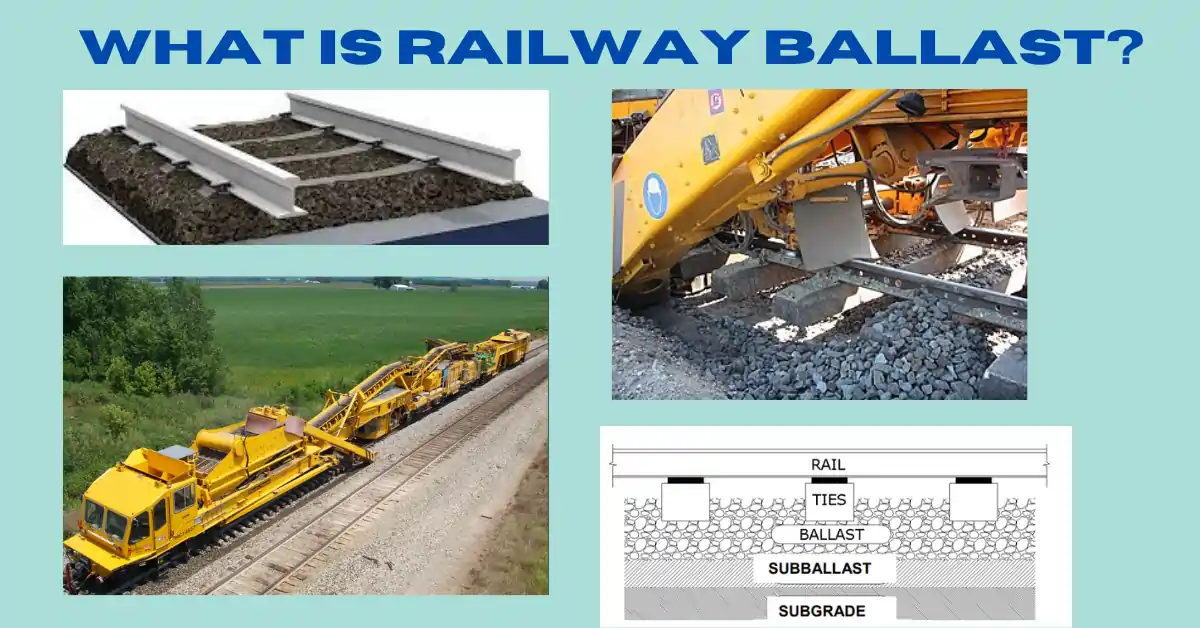Railway ballast is typically a layer of coarse, angular stones or gravel that is also called macadam which is a part of the railway superstructure. It forms the base upon which the railroad ties or sleepers are laid. It is packed between, below, and around the ties to bear the compression and horizontal forces of the railroad ties, rails, and rolling stock. It also keeps away fine material, facilitates drainage, and keeps down vegetation that can compromise the integrity of the combined track structure.
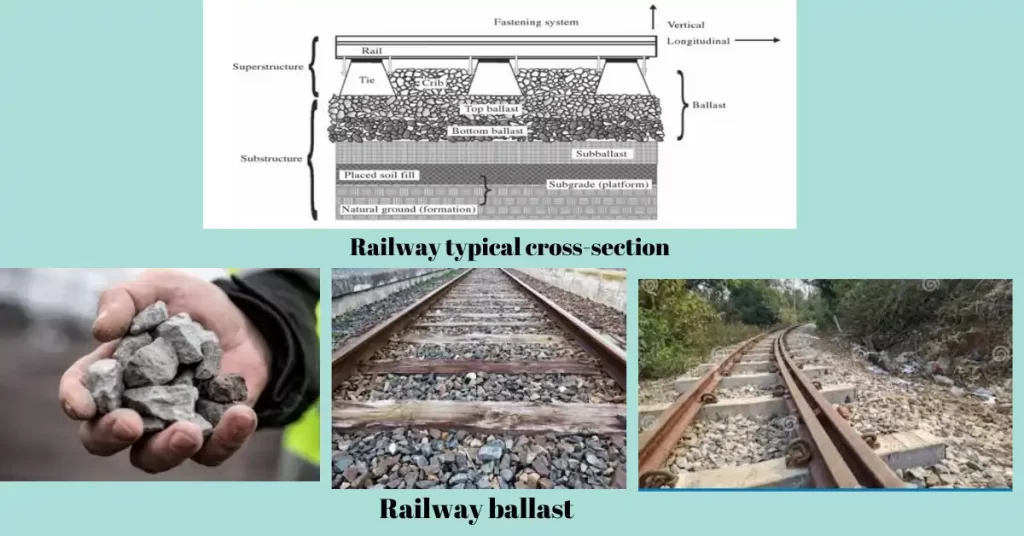
Railway ballast use history
Railway ballast material has been used in various forms through time. The history of railway ballast materials has evolved over time, reflecting advances in engineering, technology, and the availability of suitable resources. Here’s an overview of the historical use of railway ballast materials:
1. Early Railroads (18th and 19th centuries):
– Wooden Sleepers: In the earliest days of railroads, wooden sleepers (also known as ties) were placed directly on the ground to support the tracks. Ballast was not used extensively during this period.
2. Stone and Gravel (Mid-19th century):
-Cinders and slag from steam engines were being used as ballast till the demise of steam engine railways in the 1950s.
– As rail networks expanded, it became clear that a more stable and durable track foundation was needed.
– Crushed Stone: Crushed stone, such as granite or limestone, began to be used as ballast material. It provided better stability and drainage than the previous methods.
– Gravel: Gravel was also commonly used due to its accessibility and effectiveness in distributing loads.
3. Introduction of Standardization (Late 19th century):
– The late 19th century saw the establishment of standardized track designs, including the specification of ballast materials and dimensions.
– Engineers recognized the importance of consistent ballast quality and size for track stability.
4. Modernization (20th century):
– Steel Sleepers: Steel sleepers started to replace wooden ones, offering improved durability and compatibility with ballast systems.
– Crushed Rock: Crushed rock, including harder stones like basalt, became a preferred ballast material due to its superior load-bearing capacity and resistance to deformation.
5. Innovations (Late 20th century and beyond):
– Advances in technology and engineering led to the development of specialized machinery for ballast cleaning, rejuvenation, and maintenance.
– Recycling and reusing ballast material has become more common, reducing waste and cost.
Today, the choice of railway ballast material depends on factors like local availability, cost, track requirements, and environmental considerations. Commonly used materials include crushed rock, gravel, and crushed stone. The quality and size of ballast are carefully specified to ensure proper drainage, load distribution, and track stability, all of which are critical for the safe and efficient operation of modern rail networks.
The materials that were used as ballast are:-
1. Crushed Stone: Good quality track ballast is made of crushed stone. The sharp edges help the particles interlock with each other.
2. Washed Gravel: Another material used as track ballast is washed gravel.
3. Bank Run Gravel: Unwashed gravel, also known as bank run gravel, has been used as track ballast.
4. Torpedo Gravel: Torpedo gravel is a mixture of coarse sand and small gravel.
5. Slag: Slag has been used as track ballast.
6. Chats, Coal Cinders, Sand, and Burnt Clay: These materials have also been used as track ballast.
Rail ballast material and standards
The selection of the type of ballast depends on the type and density of the traffic. The ballast material for main traffic lines is commonly covered by regional gradation specifications. The ballast materials should be Strong, durable, stable, drainable, workable, easy to clean, resistant to deformation or elastic, readily available, and reasonably priced.

The ballast material should create enough friction resistance to the movement of the ties and therefore angular crushed stones or macadam are the preferred material type. They should retain no water, not disintegrate due to traffic or tamping, and be clean of dust and vegetation.
Early railway engineers used inexpensive and readily accessible materials such as cinders from locomotive fireboxes, ashes, chalk, clay, and soil because they did not grasp the value of high-quality track ballast. It became quickly apparent that good-quality rock ballast was required for a solid foundation and adequate drainage.
High-grade track ballast is composed of crushed natural rock with particles between 28mm and 50mm in diameter. However, sizes between 6-64mm can be used in some lines.
A high proportion of particles smaller than this will diminish its drainage qualities, and a high proportion of larger particles results in an incorrect distribution of the weight on the ties. The types of rock that can be used for ballast are granite, traprock, quartzite, carbonate rocks, and slags.
An example of ballast specification for a project is “Supply crushed stone ballast that is hard, dense, of angular particle structure providing sharp corners and cubical fragments, free of deleterious materials. Provide ballast material that has a high resistance to temperature changes, chemical attack, high electrical resistance, low absorption properties, and free of cementing characteristics”
There are numerous railway ballast specification standards that are followed in different countries. Here are some examples:
- British Standard BS EN 13450: This standard specifies the requirements for aggregates used in the construction and maintenance of railway track systems in the UK.
- European Standard EN 13450: This standard specifies the requirements for aggregates used in the construction and maintenance of railway track systems in Europe.
- American Railway Engineering and Maintenance-of-Way Association (AREMA) Manual: This manual provides guidelines for the design, construction, and maintenance of railway track systems in North America. It includes specifications for railway ballast materials.
- Indian Railway Standard Specification (IRS): This specification provides guidelines for the selection of suitable materials and grading requirements for different track structures in India.
- Japanese Industrial Standards (JIS): JIS provides specifications for railway ballast materials used in Japan.
- Australian Standard AS 2758.7: This standard specifies the requirements for the quality and suitability of aggregates for use as railway ballast in Australia.
Please note that these standards are not exhaustive, and there may be other standards followed in different countries.
Functions of railway ballast
Railway ballast plays several critical functions in supporting the infrastructure and operation of a railroad system. These functions include:
1. Load Distribution: Ballast evenly distributes the weight of trains, locomotives, and rolling stock, preventing excessive stress on the underlying subgrade.
2. Track Stability: It ensures the proper level and alignment of railway tracks is maintained, which is essential for safe and efficient train travel.
3. Drainage: Ballast facilitates proper drainage, allowing rainwater and moisture to flow away from the track. The drainage characteristics drain away water and protect the substructure. This prevents waterlogging, soil erosion, accumulation of snow in cold regions, and trackbed degradation.
4. Track Alignment: By resisting lateral movement, ballast helps maintain the correct alignment of the tracks, preventing shifts that could lead to derailments.
5. Subgrade Protection: It has elastic property that protects the natural subgrade (the ground beneath the track) from damage caused by heavy loads, reducing the risk of settlement and deformation.
6. Resistance to Track Movement: Ballast resists the movement of the tracks under the dynamic forces of passing trains, helping to maintain track geometry.
7. Noise and Vibration Damping: Ballast can help reduce noise and vibrations generated by passing trains, benefiting nearby communities and the environment.
12. Vegetation Control: The density of ballast discourages the growth of vegetation between and alongside the tracks, reducing the need for frequent vegetation management.
Railway ballast cleaning
Railway ballast cleaning is a specialized maintenance process crucial for maintaining the integrity and performance of railroad tracks to prevent or maintain railway track fouling or contamination. . Railway track fouling is the phenomenon where the ballast composition changes to finer particles and it causes the degradation of the stability of the structure.
Ballast cleaning involves the systematic cleaning and rejuvenation of the ballast bed, which is the layer of crushed stones or gravel beneath the railway tracks.
Why is ballast cleaning needed?
Over time the high quality of ballast is found to be necessary for the smooth operation of railway traffic as well as long-term benefits of longer life span and reduction of cost of maintenance.
Hence, railway ballast cleaning is one of the main maintenance routines that aims to restore and enhance the functionality of the ballast bed beneath railway tracks. Over time, ballast can become contaminated with fine particles, debris, and other materials, leading to reduced drainage, poor track stability, and overall track degradation. Ballast cleaning is designed to address these issues.
The process typically involves the following steps:
1. Excavation: Specialized machinery, such as ballast cleaners or track renewal trains, excavates the contaminated ballast from beneath the tracks.
2. Screening: The excavated ballast is transported through a series of screens and conveyors to separate and remove fine particles, debris, and contaminants. The cleaned ballast is then returned to the trackbed.
3. Decontamination: During the screening process, any damaged or unusable ballast is discarded, while reusable ballast is cleaned and repositioned in the trackbed.
4. Tamping and Profiling: The track is realigned and re-leveled using tamping machines to ensure proper track geometry and stability. This step may also involve the addition of fresh ballast where needed.
5. Final Dressing: The track is topped up with a layer of clean ballast to achieve the desired track geometry and drainage properties.
Railway ballast cleaning helps to:
– Improve drainage and prevent waterlogging.
– Maintain track alignment and stability.
– Enhance load-bearing capacity.
– Extend the lifespan of ballast and track components.
– Ensure safe and smooth train operations.
By regularly performing ballast cleaning, rail operators can extend the life of their tracks, reduce maintenance costs, and provide a safer and more efficient rail network for both passengers and freight transport.
Railway ballast cleaning machines
Railway ballast cleaning machines are essential for maintaining the integrity and functionality of railway tracks. Here are some types and models of railway ballast cleaning machines:
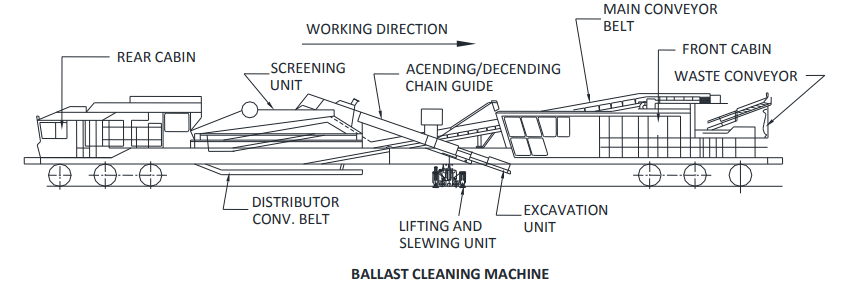
1. Plain Track Ballast Cleaning Machine RM-80: This machine is designed for cleaning plain tracks and is a railway maintenance equipment produced by Plasser and theurer.
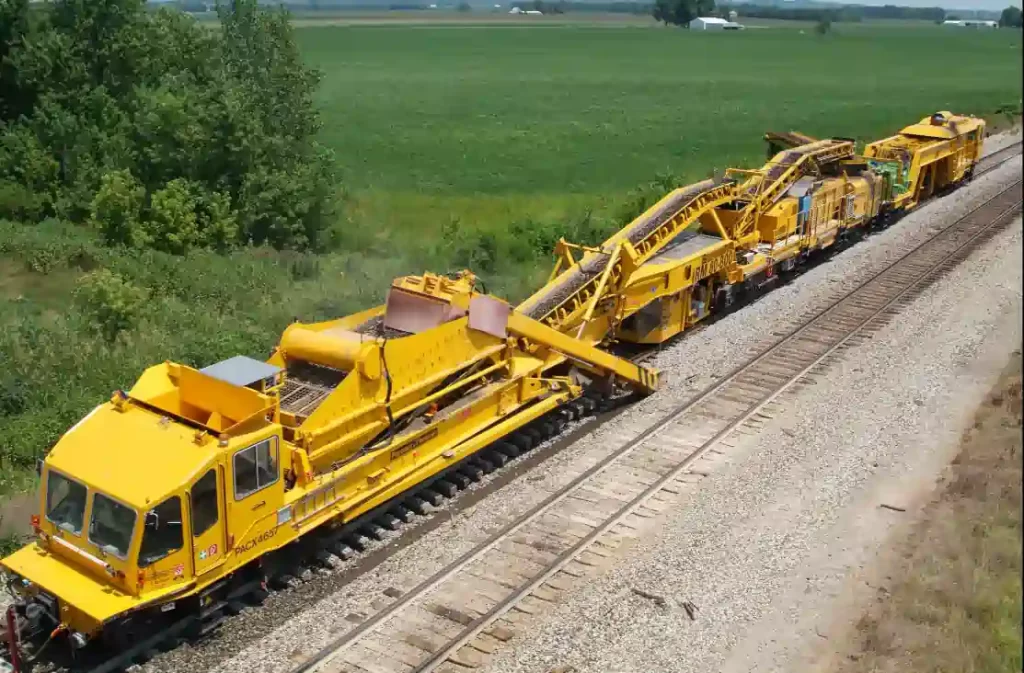
2. MATISA C 75 is a small, high-output ballast cleaner that can be deployed on both short and long, complex work sites because of its quick ramp-in and ramp-out capabilities. Even during the ramp-in period, its effective guiding mechanism enables great work quality while securely employing the entire working gauge. Due to its size, it can clean ballast at a rate of 750 m3/h and excavate ballast at a rate of up to 1000 m3/h.
4. REM Z45-II The REM Z45-II undercutter ballast-cleaner is a medium- and heavy-duty ballast-cleaning machine for use on railroad track beds. The machine can remove waste ballast using excavator chains and then feed it to the ballast hopper using a lifting guide without having to remove the rails and sleepers.

5. SRM – 2000 Ballast-Cleaning-Machine

3. Shoulder Ballast Cleaning Machine (SBCM): The SBCM is used for cleaning the ballast on the shoulders of railway tracks.

4. High Output Ballast Cleaner (HOBC): The HOBC is a self-propelled machine that can clean up to 1,000 meters of track per hour.
Please note that these are just a few examples of railway ballast cleaning machines. There may be other types and models available depending on specific requirements and technological advancements in the field.
Operation mechanism of RM-80 ballast cleaning machine
The RM-80 ballast cleaning machine is a specialized piece of railway maintenance equipment designed for cleaning and rejuvenating railway ballast. It typically consists of several key units and components to perform its functions effectively. While specific configurations may vary between models, here are the primary units commonly found in an RM-80 ballast cleaning machine:

1. Excavation Unit:
– The excavation unit is responsible for removing the existing ballast from beneath the railway tracks. It typically employs a cutting chain that can be adjusted under the sleepers to precisely align with the desired depth and cross-fall and thus follow the ballast profile uniformly. Thus the track formation can be excavated accurately laterally and longitudinally. If necessary the sleepers can be lifted. The excavation depth can be adjusted to 1200mm.
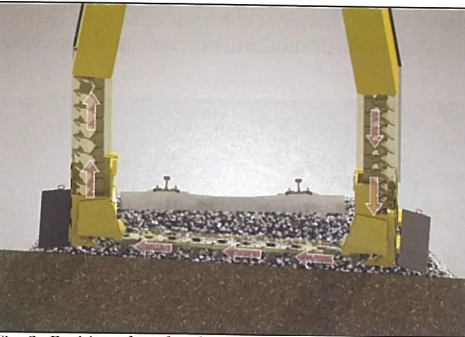
The cutting chain consists of scrape plates and 2-6 fingers. The fingers loose the ballast and the scraper plates push the material to be conveyed to the screening unit.
2. Screening Unit:
– The excavated ballast is conveyed to the screening unit, where it undergoes a screening process. This unit uses a series of screens and sieves to separate fine particles, debris, and contaminants from the ballast material. The screens have vibrating multiple decks of mesh sizes of 80/50/40 mm which are used to separate the selected material sizes.

3. Decontamination Unit:
– After screening, the decontamination unit further processes the ballast, removing any damaged or unusable material and retaining the clean, reusable ballast.
4. Conveyor System:
– Conveyor belts and systems are used to transport the ballast through various stages of the cleaning process, including excavation, screening, and decontamination.
5. Hopper and Storage Unit:
– This unit temporarily stores and manages the cleaned ballast before it is returned to the trackbed. It ensures a continuous supply of clean ballast for track replenishment.
6. Tamping and Profiling Unit:
– The tamping and profiling unit is responsible for re-aligning and leveling the track. It uses specialized tamping machines to achieve the desired track geometry and stability.
7. Ballasting Unit:
– The ballasting unit adds a layer of clean ballast conveyed from the screening unit evenly on the top of the track or to selected locations to achieve the desired track profile and ballast depth.
8. Control and Monitoring System:
– The RM-80 typically includes a control and monitoring system that allows operators to oversee and adjust various parameters of the cleaning process, ensuring it is carried out effectively and safely.
9. Power Source:
– Depending on the model, the RM-80 may be powered by a diesel engine or other power sources to drive the various units and components.

These units work in concert to excavate, clean, and rejuvenate the ballast beneath railway tracks, ensuring that the track remains stable, aligned, and capable of providing safe and efficient rail operations. The RM-80 and similar ballast cleaning machines are vital tools in railway maintenance to extend the life of track infrastructure and ensure passenger and freight train safety.
In conclusion, railway ballast is a crucial component of the railway superstructure, serving as the foundation for railroad tracks. It consists of coarse, angular stones or gravel and plays essential functions, including load distribution, track stability, drainage facilitation, and subgrade protection. The history of railway ballast materials has evolved over time, with the use of materials like crushed stone, gravel, and slag, driven by the need for stability and durability.
Railway ballast cleaning is a specialized maintenance process that involves excavating, screening, decontaminating, and re-aligning the ballast to maintain track integrity. Various types of ballast cleaning machines, such as the RM-80, are used for this purpose, featuring units like excavation, screening, decontamination, conveyor systems, tamping, ballasting, and control systems. These machines are essential for extending the life of railway tracks and ensuring safe and efficient train operations.

